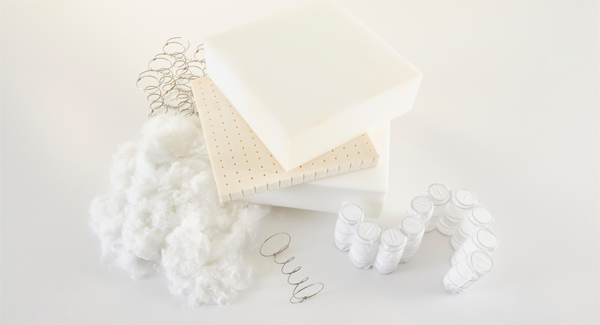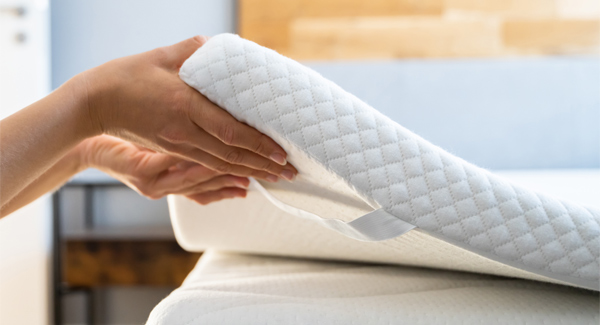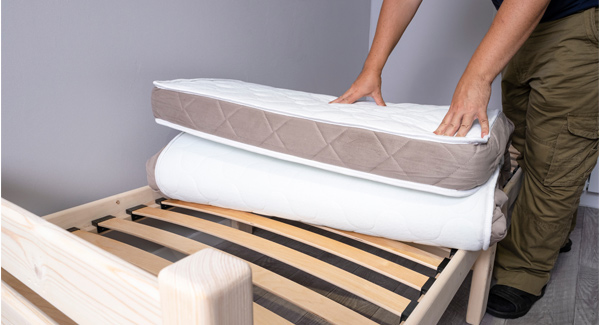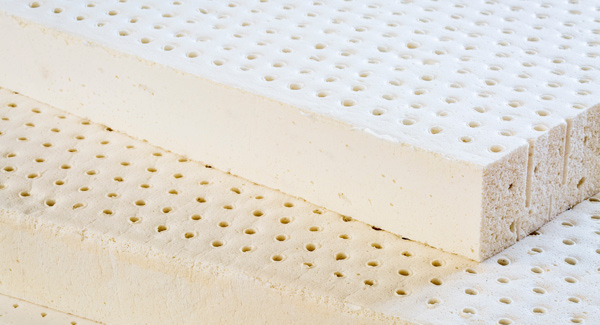Home » Mattress advice » What’s Inside A Mattress, And Why It Matters?
What’s inside a mattress, and why it matters?
Article navigation
- Published:
- Written by: Tony Brown
- Topic: Mattress advice
The quality of a mattress depends heavily upon the components used inside. Understanding the purpose of these components and weighing up their pros and cons can help you decide which mattress is right for you.
Cover or ticking
One of the first things you will notice when shopping for a new mattress is the cover or ticking. The cover is typically made from a durable and tightly- woven material, such as Belgium Damask, that is designed to resist wear and tear. Some mattresses may come with a choice of fabrics.
Most mattresses come with a quilted or tufted sleeping surface. Quilted mattresses have a smoother, flatter surface, whereas tufted mattresses have a contoured surface.
Vents
Air vents are small perforations or holes that run along the sides of the mattress to improve airflow and prevent the build-up of moisture.
Support and comfort layers
Mattresses are made with different layers for support and comfort. The layer combination will be different for each mattress but will typically consist of support and comfort layers.
Support layer
The purpose of the support layer is to ensure the body is aligned and properly supported.
Spring interiors
The majority of mattresses contain springs. Although there is a broad selection of spring systems, open coils and pocket springs are the most common types.
Open coil
Open coil spring units are made from a continuous wire made into a series of coils. Open coils springs are widely used by manufacturers as they are inexpensive to produce. As movement is transferred across the entire surface, open coils are less effective at conforming to body shape than other materials. Open coil springs can feel quite bouncy, which means sleeping partners may disturb one another when they turn over in bed.
Pocket springs
Pocket springs are more responsive to body shape. Each spring works independently to ensure the body is properly supported. The individual springs help eliminate movement and roll-together. Pocket springs can be made in different firmness levels by changing the thickness of the wire.
Some mattresses contain low-height micro or mini springs providing an extra comfort layer. Like pocket springs, each micro or mini spring moves independently to adapt to body shape. Micro and mini springs are resilient, which helps the mattress retain its shape and avoid premature sagging.
Comfort layers
Mattresses use various fillings to create a distinct feel. The comfort layers are located near the mattress’s surface, above the support layer. Mattresses may be filled with synthetic materials, such as foam and polyester, or natural materials, such as wool, cotton, and hair. Fillings are chosen for their comfort, durability, and ability to absorb moisture.
Filling quantity and quality can vary from one mattress to the next. Cheaper mattresses often contain synthetic materials, whereas higher-quality mattresses often contain generous amounts of natural upholstery to provide a more luxurious feel.
Foam
Foam is commonly used in mattresses for its cushioning and pressure-relieving properties.
Memory foam
Memory foam is a temperature-sensitive material that gently moulds and adapts to the body. The material evenly distributes weight and mattress across the mattress, ensuring the body is properly supported. Though memory foam is suitable for all sleeping positions, side sleepers may find it particularly beneficial due to its ability to cushion and cradle the shoulders and hips.
Natural Latex
Latex is a premium material that has similar characteristics to memory foam. It is derived from the sap of rubber trees and offers an environmentally friendly alternative to memory foam. Latex conforms to body shape but responds almost immediately, preventing over-sinking into the mattress. Its pin-hole structure provides good ventilation, allowing the material to breathe.
Latex is also hypoallergenic and dust mite resistant.
Polyester
Polyester is a synthetic material commonly used in mattresses. It is strong, durable and typically cheaper than other materials, making it a cost-effective option for mattresses. Polyester is also a breathable material, which can help keep you cool and dry throughout the night.
Some mattress covers contain polyester because the material is resident to wrinkles and shrinkage.
Coir fibre pads
A coir fibre pad is a natural material made from coconut husks. Coir is typically placed above the springs to provide insulation and a durable support layer.
Wool
Soft and supportive, wool is often used in higher-quality mattresses. Its unique properties allow it to absorb and release moisture, keeping you dry and comfortable in bed. It is also a natural insulator, keeping you warm in the winter and cool in the summer.
Wool is a naturally elastic material that can bend up to 20,000 times without breaking. Wool, therefore, is a resilient material that can maintain its shape long-term.
The material is hypoallergenic and resistant to dust mites, appealing to asthma and allergy sufferers. Unlike synthetic materials, wool is naturally fire-retardant.
Cotton
Cotton is a soft and strong fibre that is often used near the surface of the mattress. Like wool, cotton is comfortable and breathable. The material is durable and hypoallergenic.
Hair
Often described as ‘nature’s spring’, hair is a strong, bouncy, and resilient fibre that maintains its shape and support over time. It is naturally breathable and hypoallergenic.
Cashmere
Cashmere is a luxurious material with a soft texture. The material has excellent insulating properties and is significantly warmer and lighter than wool.
Silk
Silk is an indulgent fibre that is strong, comfortable, and breathable. Like wool, silk is a thermal insulator, so not only will it help you feel cool and comfortable in bed, it also keeps you warm and cosy when needed.
It is naturally hypoallergenic and dust mite resistant, ideal for those with asthma or allergies.
Bamboo
Bamboo, sometimes referred to as ‘green steel’ is known for its durability and strength. It is soft, breathable and has excellent temperature-regulating properties. Bamboo is highly sustainable and environmentally friendly due to its fast-growing nature.
Hemp
Hemp is derived from the Cannabis sativa plant, but contains very low levels of intoxicants (THC), the ingredient that makes Cannabis a drug. Hemp is a soft and luxurious material, making it ideal for mattresses. It is highly absorbent and effective at drawing moisture away from the body, ensuring you remain cool, fresh, and comfortable at night.
Hemp is naturally hypoallergenic, meaning it is less likely to cause allergies or skin irritations than other materials.
Mattress thickness
Mattress thickness also depends on the layer combinations and the quality of construction. Most mattresses tend to be between 10 and 14 inches deep.
Final thoughts
Mattresses may look similar, but the differences inside are significant. Though choosing a mattress often comes down to comfort and support, it helps to understand what’s inside the mattress and how it has been constructed to determine whether you’re getting value for money.
Share this article

About the author
Tony Brown is the founder and creator of The Bed Consultant. His career in the bed industry began in 2002. After graduating from university with a degree in Business Administration, Tony joined one of the largest independent furniture retailers in the UK as a bed consultant. Tony has helped thousands of customers find the perfect mattress.





